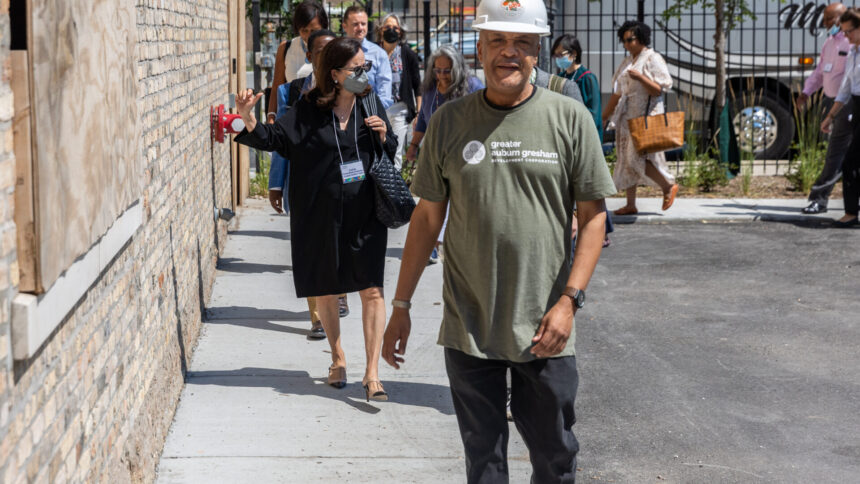This blog post was written in collaboration with CFLeads and Urban Institute.
In response to the growing awareness of the roles community foundations play in advancing economic mobility, CFLeads launched a new economic mobility webinar series, featuring community foundations and partners.
In the third webinar of the series, “Empowering Local Communities: Urban Institute’s Upward Mobility Framework and How Community Foundations Can Use It,” Urban Institute experts shared the Upward Mobility Framework and explored how community foundations can play a key role in cross-sector partnerships.
Roles of Community Foundations in Advancing Economic Mobility
One of the main cornerstones of a thriving community is having the means to enable its residents to achieve upward mobility and economic prosperity. Community foundations play many roles to bring about this change, and their roles evolve along with the needs of their communities. While many community foundations strategically invest in initiatives that align with their goals, they can also champion policy work, convene key stakeholders, and determine outcomes by setting grantee reporting requirements.
The Urban Institute, a nonprofit research and policy organization dedicated to elevating the debate on social and economic policy research, has developed resources to help localities promote upward mobility and advance equity, including Upward Mobility Framework, Mobility Metrics, and Planning Guide for Local Action. How each resource can support community foundations in their work is explained below.
Upward Mobility Framework
The Upward Mobility Framework defines upward mobility not only in terms of economic success but also in terms of power and autonomy, and dignity and belonging. The Framework has five essential pillars supporting mobility from poverty:
- Opportunity-rich and inclusive neighborhoods
- High-quality education
- Rewarding work
- Healthy environment and access to good health care
- Responsive and just governance
Under each pillar are 4 to 5 predictors, or evidence-based factors, strongly associated with the likelihood that a community can create the conditions necessary to advance the economic and social mobility of its residents while narrowing racial and ethnic inequities.
Mobility Metrics
For each predictor, Urban has identified 1 to 2 metrics that can assess the pillars that support upward mobility. For example, to measure the “preparation for college” predictor under the high-quality education pillar, Urban uses the metric “share of 19- and 20-year-olds with a high school degree.”
There are 26 metrics for 24 predictors within the Upward Mobility Framework. The metrics are organized into mobility metrics data tables that can be assessed at the county or city level, and they can be used to compare and monitor a community’s performance over time. By analyzing the locality’s Mobility Metrics, community foundations can gain a deeper understanding of the specific challenges and opportunities that exist in their communities, enabling them to support targeted strategies and interventions. They can also use the metrics to inform planning for initiatives that address the root causes of economic inequality.
Planning Guide for Local Action
To further support community foundations in their efforts to drive upward mobility and advance equity, Urban has created a Planning Guide for Local Action with step-by-step instructions and practical tools for developing and implementing effective strategies. The guide includes suggestions for building a cross-sector team, conducting a community needs assessment, engaging key stakeholders, setting measurable goals, and evaluating the impact of interventions. By following the guide, community foundations can assist local governments and stakeholders to ensure that their efforts are strategic, impactful, and sustainable.
How Community Foundations Can Leverage the Resources
There is an opportunity for community foundations to identify and choose their role in enacting systems change. They can use the three resources in the following ways to help support the needs and goals of their communities:
- Data-informed decision making: Community foundations can use the Mobility Metrics to identify areas of greatest need and prioritize their investments accordingly. By understanding the specific challenges their communities are facing, they can allocate resources to programs and initiatives that address the most pressing issues.
- Collaborative partnerships: The Upward Mobility Framework emphasizes the importance of multisector collaboration, data-driven decisionmaking, and equitable policies. Community foundations can leverage their resources to identify potential partners, such as local government agencies, educational institutions, and nonprofit organizations, to collectively work toward shared goals. By fostering partnerships, they can pool resources, expertise, and influence to create a more comprehensive and impactful approach to upward mobility.
- Strategic planning and implementation: The Planning Guide for Local Action offers a systematic approach to developing and implementing initiatives. Community foundations can use this guide to gather community input, set clear goals, and design evidence-based strategies. This structured planning process ensures that resources are allocated effectively and that interventions are aligned with community needs, maximizing the potential for success.
- Evaluation and learning: Community foundations can use the evaluation and learning tools and methodologies provided in the three resources to measure the outcomes and impact of their initiatives. By continuously monitoring and evaluating their efforts, they can identify areas for improvement, make data-driven adjustments, and share best practices with other community partners.
Community foundations have a unique opportunity to drive upward mobility and create positive change in their communities. By leveraging Urban’s Mobility Metrics, Upward Mobility Framework, and Planning Guide for Local Action, they can catalyze systemic change, break down barriers, and drive upward mobility—ultimately, creating a stronger and more equitable society for all.
Stay tuned for more information about our next webinar in the economic mobility series! We look forward to highlighting more community foundations and partners that are working to advance upward mobility in their communities.
Stay tuned also for Urban’s forthcoming resources specifically developed for community foundations by signing up for updates on the Upward Mobility Framework project.
Interested in learning more about and becoming involved in CFLeads’s future economic mobility work? Complete the short interest form below.




